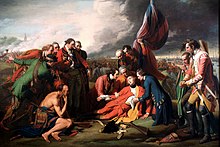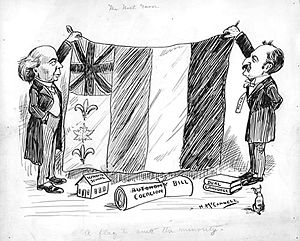Canadian identity
[13] In defining a Canadian identity, some distinctive characteristics that have been emphasized are: Canada's large geographic size, the presence and survival of a significant number of indigenous peoples, the conquest of one European linguistic population by another, and relatively open immigration policy have led to an extremely diverse society.
[20] Each of the indigenous peoples developed vibrant societies with complex economies, political structures and cultural traditions that were subsequently affected profoundly by interaction with the European populations.
The Métis are an indigenous people whose culture and identity was produced by a fusion of First Nations with the French, Irish and Scottish fur trade society of the north and west.
The English Canadian writer and philosopher John Ralston Saul also considers the Ultramontane movement of Catholicism as playing a pivotal and highly negative role in the development of certain aspects of Québécois identity.
American colonists who remained loyal to the Crown and who actively supported the British during the Revolution saw their lands and goods confiscated by the new republic at the end of the war.
This population formed the nucleus for two modern Canadian provinces—Ontario and New Brunswick—and had a profound demographic, political and economic influence on Nova Scotia, Prince Edward Island and Quebec.
According to the author and political commentator Richard Gwyn while "[t]he British connection has long vanished...it takes only a short dig down to the sedimentary layer once occupied by the Loyalists to locate the sources of a great many contemporary Canadian convictions and conventions.
The War of 1812 also saw the invasion of American forces into what was then Upper and Lower Canada, and important British victories at Queenston Heights, Lundy's Lane and Crysler's Farm.
The Americans however captured control of Lake Erie, cutting off what is today western Ontario; they killed Tecumseh and dealt the Indian allies a decisive defeat from which they never recovered.
[26] The years following the War of 1812 were marked by heavy immigration from Great Britain to the Canadas and, to a lesser degree, the Maritime Provinces, adding new British elements (English, Scottish and Protestant Irish) to the pre-existing English-speaking populations.
The hostility of other groups to the autocratic colonial administrations that were not based on democratic principles of responsible government, principally the French-speaking population of Lower Canada and newly arrived American settlers with no particular ties to Great Britain, were to manifest themselves in the short-lived but symbolically powerful Rebellions of 1837–1838.
"[28] For its part, the French Canadians distrusted the growing anti-Catholic 'British' population of Canada West and sought a structure that could provide at least some control over its own affairs through a Provincial legislature founded on principles of responsible government.
The union of the Provinces of Canada, Nova Scotia and New Brunswick into a federation in 1867 drew on all of the primary aspects of the Canadian identity: loyalty to Britain (there would be self-governance under a federal parliament, but no rupture from British institutions), limited but significant home rule for a French-speaking majority in the new Province of Quebec (and a longed for solution to English-French tensions), and a collaboration of British North Americans in order to resist the pull and the possible military threat from the United States.
The republic to the south had just finished its Civil War as a powerful and united nation with little affection for Britain or its neglected colonies strung along its northern border.
The construction of the Canadian Pacific Railway, promised to British Columbia as an inducement to join the new dominion, became a powerful and tangible symbol of the nation's identity, linking the provinces and territories together from east to west in order to counteract the inevitable economic and cultural pull from the south.
The Red River Rebellion, led by Louis Riel, sought to defend the interests of French-speaking Métis against English-speaking Protestant settlers from Ontario.
The attention of the Dominion Government has been drawn to the fact that the children sent to Canada from England are street waifs and workhouse paupers, and that the professional philanthropists engaged in the work are largely prompted by mercenary and not charitable motives.
From the mid to late 19th century Canada had a policy of assisting immigrants from Europe, including city people and an estimated 100,000 unwanted "Home Children" from Britain.
[32] Offers of free land attracted farmers from Central and Eastern Europe to the prairies,[33][34] as well as large numbers of Americans who settled to a great extent in Alberta.
Simultaneously, the role of immigrants as loyal Canadians was contested, with large numbers of men of German or Ukrainian heritage temporarily stripped of voting rights or incarcerated in camps.
The west, particularly the oil and gas-producing province of Alberta, opposed many of the policies emanating from central Canada, with the National Energy Program creating considerable antagonism and growing western alienation.
[38] In keeping with this, it is often asserted that Canadian government policies such as publicly funded health care, higher taxation to distribute wealth, outlawing capital punishment, strong efforts to eliminate poverty in Canada, an emphasis on multiculturalism, imposing strict gun control, leniency in regard to drug use, and most recently legalizing same-sex marriage make their country politically and culturally different from the United States.
[41] In a CBC contest to name "The Greatest Canadian", the three highest ranking in descending order were the social democratic politician and father of medicare Tommy Douglas, the legendary cancer activist Terry Fox, and the Liberal prime minister Pierre Trudeau, responsible for instituting Canada's official policies of bilingualism and multiculturalism, which suggested that their voters valued left-of-centre political leanings and community involvement.
[44] As Professor Alan Cairns noted about the Canadian Charter of Rights and Freedoms , "the initial federal government premise was on developing a pan-Canadian identity"'.
Some of the "stories" for which he solicited comment included the legalization of staplers, the coronation of King Svend, the border dispute between Quebec and Chechnya, the campaign against the Toronto Polar Bear Hunt, and the reconstruction of the historic "Peter Mann's Bridge".
During the 2000 election in the United States, Mercer successfully staged a Talking to Americans segment in which presidential candidate George W. Bush gratefully accepted news of his endorsement by Canadian Prime Minister "Jean Poutine".
"[55] Saul argues that Canadian identity is founded not merely on the relationship built of French/English pragmatic compromises and cooperation but rests in fact on a triangular foundation which includes, significantly, Canada's aboriginal peoples.
[58] While the dominant culture tended to dismiss or marginalize First Nations to a large degree, individual artists such as the British Columbia painter Emily Carr, who depicted the totem poles and other carvings of the Northwest Coast peoples, helped turn the then largely ignored and undervalued culture of the first peoples into iconic images "central to the way Canadians see themselves".
[62] Canadian historians in recent decades look at the war as a defeat for the First Nations of Canada, and also for the merchants of Montreal (who lost the fur trade of the Michigan-Minnesota area).
By contrast, the Conservative provincial government of Alberta has frequently quarrelled with federal administrations perceived to be dominated by "eastern liberal elites.















